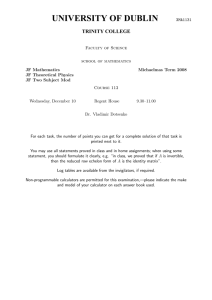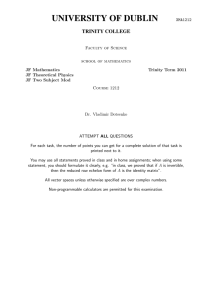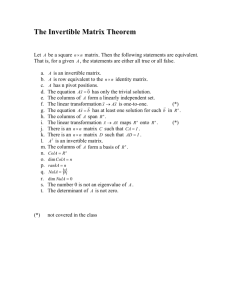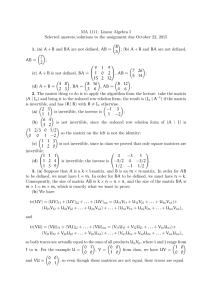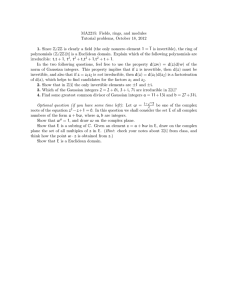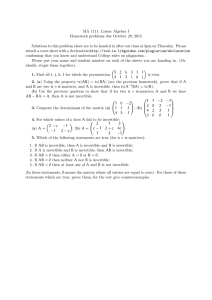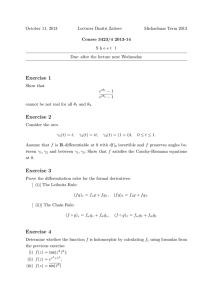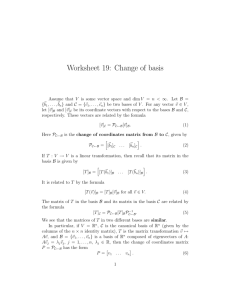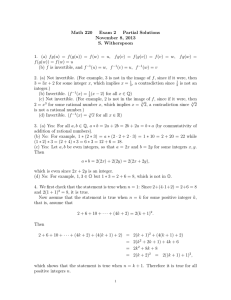. , lIfi(z)l+...+If
advertisement
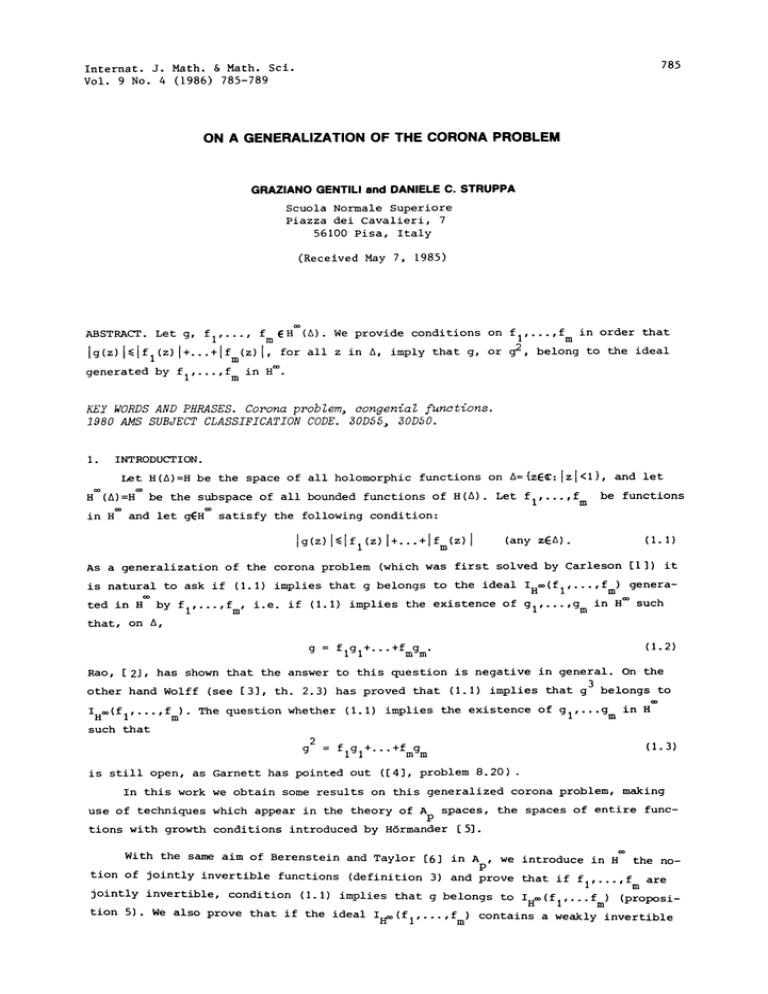
785
Internat. J. Math. & Math. Sci.
Vol. 9 No. 4 (1986) 785-789
ON A GENERALIZATION OF THE CORONA PROBLEM
GRAZIANO GENTILI and DANIELE C. STRUPPA
Scuola Normale Superiore
Piazza dei Cavalieri, 7
56100 Pisa, Italy
(Received May 7, 1985)
ABSTRACT. Let g,
.
fl’’’’’ fm EH
lIfi(z)l+...+Ifm (z)I,
generated by fl’’’’’fm in H
Ig(z)
,
fl,...,fm
(A). We provide conditions on
for all z in 4, imply that g, or
in order that
belong to the ideal
KEY WORDS AND PHRASES. Corona problem, congenial functions.
1980 AMS SUBJECT CLASSIFICATION OODE. 30D55, 30D50.
i.
INTRODUCTION.
zl<l}, and let
fl,...,f be functions
Let H(A)=H be the space of all holomorphic functions on A={zE:
tt’(A)=H
in H
be the subspace of all bounded functions of H(A). Let
and let
gH
satisfy the following condition:
Ig(z) l,<If l(z)
l+’’’+Ifm (z)
(any zEA).
(l.I)
As a generalization of the corona problem (which was first solved by Carleson [I ]) it
is natural to ask if (1 1) implies that g belongs to the ideal
ted in H
that, on
by
fl,...,fm,
i.e. if (I.I) implies the existence of
gl,...,gm
in H
generasuch
A,
g
Rao,
..,f
IH(f
(1.2)
flgl+...+fmgm.
2], has shown that the answer to this question is negative in general. On the
other hand Wolff (see [3], th. 2.3) has proved that (i.I) implies that
IH(f I,
f ). The question whether (i.i) implies the existence of
m
g3
belongs to
gl,...gm
in H
such that
g
2
(I. 3)
flg1+...+frogm
is still open, as Garnett has pointed out ([4],
problem 8.20)
In this work we obtain some results on this generalized corona problem, making
use of techniques which appear in the theory of A
D
spaces, the spaces of entire func-
tions with growth conditions introduced by H6rmander
5].
With the same aim of Berenstein and Taylor [6] in A
P
we introduce in H
tion of jointly invertible functions (definition 3) and prove that if
the no-
fl,...,fm
are
jointly invertible, condition (i.I) implies that g belongs to
f
(proposiIH(f
m
tion 5). We also prove that if the ideal
contains a weikly invertible
Ii(fl,...,fm
G. GENTILI AND D. C. STRUPPA
786
function having simple interpolating zeroes (see [3]), then again (i.i) implies that g
IH (fl
belongs to
(theorem 6)
fm
Finally, in the same spirit of Kelleher and Taylor [7] we introduce the notion
and give a partial answer to the pro-
of congeniality for m-tuples of functions in H
(fl’’’’’fm)6(H)m
blem posed by Garnett ([4]): we prove that if
g2IH(f
(i.i) implies
2.
WE/K
is
congenlal, then
(theorem 8).
fm)
INVERTIBILITY.
We first study some conditions under which (i.i) implies that
DEFINITION i. A function f in
H(A)
a Blaschke product B such that f (z) =B (z)
g61H(f
.
fm )"
is called weakly invertible if there exists
(z in A) with
(z)
. .
invertible in H
The reason for this definition is the following simple criterion of divisibility
for functions in H
PROPOSITION 2. Let
gH
fH
Then f is weakly invertible if, and only if, for all
the fact that g/fEH implies
g/fEH
.
-PROOF. Suppose f is weakly invertible: then there exists a Blaschke product B
such that f (z) =B (z)
(z)
invertible in H
with
.
Since
g/f is holomorphic and since
B contains exactly the zeroes of f, it follows that g/BEH; however, since B is a
.
Blaschke product, g/BH implies, [8], that g/BH
i.e.
Write
g/fH
f(z)=B(z)(z),
Since
I/{6H
one has
.
where B is the Blaschke product of all the zeroes of f (see
Then B/f is holomorphic on A and therefore
I/
must belong to H
.
g/f=(g/B)(i/),
such that g/fH, it follows g/fH
Conversely, suppose that for all g6H
[8]).
An extension of the notion of weak invertibility to m-tuples of functions in H
is given by the following definition, analogous to the one given by Berenstein and
Taylor for the spaces A in 6].
P
DEFINITION 3. The functions
al generated by
fl’""" ’fm6H
f in H coincides with
m
there exists a neighborhood U of z and
are called jointly invertible if the ide-
fl’
Ii,...,I
In view of Cartan’s theorem B
invertible if, and only if,
generated by
fl
in
f
m
f1’
in H
f
m
z in A. Then
m
it follows immediately that
for which there exists 6>0 such that
1’’’’’ m
fl
PROOF. Let g&H
i.e., for all z in
’fm
for any
zA,
f on U}
g=l f +. +I mm
fl
in H(A). As a consequence of the corona theorem, all m-tuples
(IH=IH=H).
If l(z) I+ +Ifm (z)I>6
in H
for all z
More generally one has:
be weakly invertible, and let
PROPOSITION 4. Let b6H
for
)={gH(A):
m
in H(U) such that
f are jointly
m
the ideal
the
latter
),
being
IH(f l,...,fm)=IH(fl,...,fm
A, are jointly invertible
=b(z) m (z)
,f
Iloc(f
such that
fl (z)=b(z)I (z)
I l(z) l+...+lm(Z)I>6>0
fm(Z)=
for some 6 and all
are jointly invertible.
IH(fl’’’’’fm )" There exist I
g(z)
1(z)fl (z)+’’’m(z)fm(z)
’%m
belong to
in H(A) such that
(all zA)
A,
g(z)
Since b is invertible, and
b(z)
ll(z)
g/bH, it follows that
na theorem, then, it follows that there are h
I,
(z)
h
(z)+...+l (z)f (z)]
m
m
=g/b=%ll+...+% m m6H
,h
m
in H
.
(2.1)
(2.2)
By the coro-
such that
l(z) l(z)+...+h m (z)m (z)
(2 3)
there fore
g(z)
(z)b(z)
h
l(z)f l(z)+...+hm (z)fm (z)
(2.4)
ON A GFNEaLIZATION OF THE CORONA PROBLEM
787
and the assertion is proved.
Let now
fl
f
[]
gH (A)
and suppose that (i. i) holds. It is well known,
that in general (i.I) does not imply that
gIlo c (fl
implies that
f
f ). However,
(i i) certainly
[]
and hence
[]
PROPOSITION 5. Let f
(i.i), it follows that
gIH=(f
2 ],
l’""" ’f [] be jointly invertible. Then if g satisfies condition
g6IH(fl,...,f
).
[]
A different situation in which (1.1) implies that
least one of the f. ’s, say f
g6IH=(fl,...,f
occurs when at
[]
is weakly invertible and has simple zeroes which for[]
I’
an interpolating sequence ([3]); this happens, for example, when
fl
is an interpolating
Blaschke product with simple zeroes ([3]). Indeed, following an analogous result proved
in [7] for the space of entire functions of exponential type, one has:
f1’""" ’fm6H’
THEOREM 6. Let
terpolating zeroes. Then if g6H
to
IH(fl
and suppose
fl
is weakly invertible with si[]ple, in-
satisfies condition (I.1) it follows that g belongs
fm )"
PROOF. Choose
i=2
aij6
m, j,>1, such that for
{z.}={zEA:f3
(z)=0}
it is
laijl=l
and a..f. (z.)0. Define now b..E (i,j as before) by
bij=I0
if
f2(zj)=...=fm(Zj)=0
[aijg(zj)/(I f2 (z j) I+...+ fm(Z
By (1.1) it follows
...,h
Ibijl<l
(all i,j), and since
{z.}
I)
otherwise.
such that h (z)=b
Therefore the function
[]
i
ij
to H and vanishes at each z.. The simplicity of the zeroes of
h=g-(h2f2+.
and the invertibility of
fl
implies
h/f1=hl6H=.
one finds h
is interpolating,
in H
fl
.+h f
2
belongs
mm
f/f16H
shows that
The thesis now follows, since
g=flhl +
+...+f h
m []
It is worthwhile noticing that the hypotheses of Proposition 5 and Theorem 6 are
not comparable. Consider, indeed, the following conditions on
(CI) f1’’’’’
(C 2) there exists
f
f1’
f
[]
H=:
are jointly invertible.
[]
(l<j<[]) such that f. is invertible, with an interpolating sequence
of zeroes, all of which are simple.
Then (C
I)
does not imply (C
2) take m=l and weakly invertible with non-simple zeroes.
2) does not imply (CI): consider fl invertible with simple
{z
interpolating zeroes
}; let f2#H be a function such that
n
f2(z n )=i/n (such a function certainly exists since
an
is
interpolating
sequence);
now
{Zn}
fl and f2 have no
On the other hand, also (C
common zeroes, and hence
it is
3.
12(Zn)=n,
i.e.
16Iloc(fl,f2)
12H.
however
Therefore the pair
lIH(fl,f2)
(fl,f2)
since if
satisfies
(C2)
1=llf1+2f2,
but not
then
(CI).
CONGENIALITY.
In this section we describe a class of []-tuples of functions in H=(A)
condition (i.I) implies that
f ).
g2IH=(f
DEFINITION 7. An []-tuple
for all i,j=1
(f1’’’" ’f
where
f(z)
m
of functions in H
is called congenial if
[]
(fif_fjf)/ f2f,
2
[]
for which
Ifl(z) 12+ .+Ifm (z)
2
belongs to
L=(),
IIf’ (z)ll 2 =If{ (z) 2+. .+If’ (z)
[]
2
and
f i /z
f=
1
G. GENTILI AND D. C. STRUPPA
788
Notice that the class of congenial m-tuples is not empty. Indeed, one might consi-
der pairs
fl,f2
in H
which, at their common zeroes, satisfy some simple conditions on
their vanishing order easily deducible from Definition 7. For example, one can ask that
fl(z0)=f2(z0 )=0’ f(z0)0’ f;(z0)=0"
As a partial answer to problem 8.20 in [4], we
prove the following
fl,...,fm,g6H(A),
THEOREM 8. Let
sfies (I.i), then
g26IH(fl
fm
and suppose
(fl,..,f)
m
)’ i.e. there are
2
g (z)
be congenial. If g sati-
gl’’’’’gm
such that (on A)
in H
(3. I)
fl(z)g1(z)+’’’+fm(Z)gm(Z)
PROOF. We mainly follow the proof due to Wolff, [3], of the fact that (1.1) implies
g36IH..
that
(j
fj-<l,
We can assume
is bounded and C
on
)
g.-<l,
and
fj,gH()
j=gj/If 2
m). Put
(j=l
and consider the differential equation
abj,k/ ja k/9 g2Gj, k
(3.2)
(l<,j,k<n)
for
If
in
exist, then clearly
solutions_ bj,k(L
(indeed
’."
gj=0
and
is bounded on A).
gj
it is enough to show that
measures for l-<j,km.
2
As far as g
k
Ig2Gj, kl21g(I/Izl)dxdy
Gj, 121og(I/Izl)dxdy
(fl
fm)
it is
g
-%,
On the other hand,
-
<-
gJ=gJ+ kT"(bj’k-bk’j)fkEH
and (3. I) holds
In order to prove that (3.2) admits a solution
2
and (g
are Carleson
is concerned, notice that
Gj,k)/z
by the congeniality of
IglIAa 12 I[f_(f.f-fkf.). l/Ifl m -< cl’l
-.
(g2Gj,k )/z 2gg’Gj,k+gGj,k/Z;
again by the congeniality of
(f1’’’" ’fm )’
one has
Igg’=a,I <-Igllg’llIIl fff-ff.I/Ifl 6 < c(Ig’ 12+llf’l12)/Ifl
-< c{l’
-<
Im/i(l+lf’12/l:l,
and
le2aG3,/azl
<- c
112"111 7zql’l. z(z-&/ll
8
+
l}.12/lzl.
This concludes the proof.
ACKNOWLEDGi.ENT. Theauthors wish to thank Professor Carlos A. Berenstein for reading a
preliminary version of this paper. They also gladlyacknowledge the Ministero P.I. of
the Italian Government and the University of Maryland for their financial support.
ON A GENERALIZATION OF THE CORONA PROBLEM
789
REFERENCES
i. CARLESON, L. Interpolation by Bounded Analytic Functions and the Corona Problem,
Ann. of Math. (2)76 (1963), 547-559.
2. RAO, K.V.R.
3. GARNETT, J.B.
On a Generalized Corona Problem, J. Anal. Math. 18(1967), 277-278.
Bounded AnalyticFunctions, Academic Press, New York, 1981.
4. BARTH, K.F., BRANNAN, D.A. AND HAYMAN, W.K. Research Problems in Complex Analysis,
Bull. London Math. Soc. 16 (1984), 490-517.
5. HORMANDER, L. Generators for Some Rings of Analytic Functions, Bull. Amer. Math.
Soc. 73 (1967), 943-949.
cn
6. BERENSTEIN, C.A. and TAYLOR, B.A. Interpolation Problems in
with Applications
to Harmonic Analysis, J. Anal. Math. 38 (1980), 188-254.
7. KELLEHER, J.J. and TAYLOR, B.A. Finitely Generated Ideals in Rings of Analytic
Functions, Math. Ann. 193 (1971), 225-237.
8. HOFFMAN, K. Banach Spaces of Analytic Functions, Prentice Hall Inc., Englewood
Cliffs, 1962.
